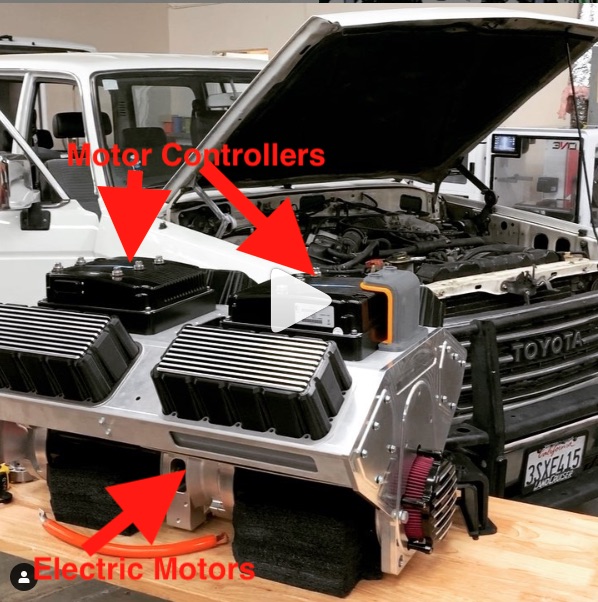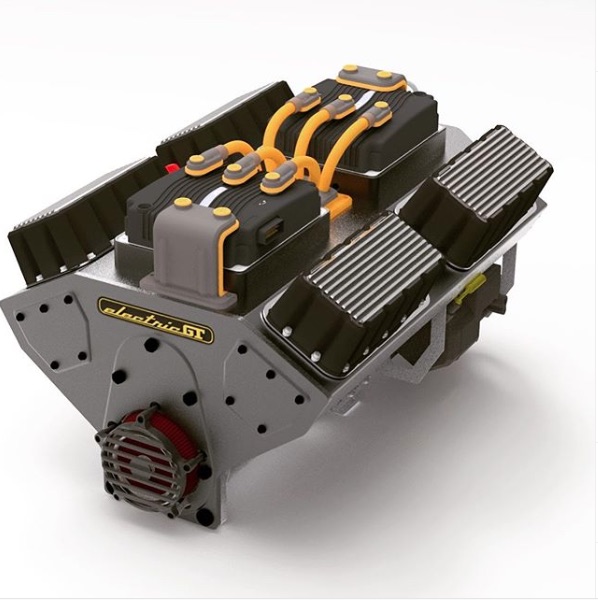What if you have a hankering for a specific car, like the 1967 Mustang, but you want it to be electric rather than powered by the 287 cubic inch gasser engine Ford sold it with. There is a whole subculture of folks converting gas cars to electric, most of whom are doing it in their garage. There is a small industry of shops manufacturing and selling parts to convert gas cars to be electric cars, and even a handful of businesses doing the conversion for others. A commonality of every EV conversion is the task of mounting an electric motor in place of the gas engine along with mounting the required parts like the motor control, contactor, and DC-DC converter. A relatively new company on the scene, Electric GT, has a product, a “crate motor” akin to the “crate engines” that hot-rodders use to build high power gasser cars.
The promise of the Electric GT crate motor is that it’s a drop-in replacement for a gas engine. You rent an engine hoist, lift the engine out, set it aside, then use the engine hoist to put in the electric motor in. There is of course a few more tasks like getting and installing a battery pack, but this is supposed to greatly simplify the whole project.
The product is a metal frame roughly in the shape of a V8 engine. Mounted to the frame are a pair of electric motors, such as the “AC50” or “AC51” motors commonly used in EV conversions, along with parts like a pair of motor controllers, and a DC-DC converter. The crate motor is sized so it fits into the same footprint as a V8 engine so that one can be swapped in to replace the existing gas engine.
This video shows the concept, starting with a close-up of the crate motor, panning over to the V8 engine it is due to replace, then panning back to the crate motor.

In another Instragram posting![]() , the ElectricGT staff describe the crate motor project this way:
, the ElectricGT staff describe the crate motor project this way:
The “Crate” includes a laundry list of typically overlooked EV items required: twin motors, twin controllers, liquid cooled charger, contactor box, AC compressor, DC converter, cooling system, electric brake vac, aluminum lightened clutch assembly, and bolt in installation. Dump engine, cooling system, gas tank(s), exhaust system, and ? there is space. A neat option for the right application(s).
Source: Electric GT on Instagram
Having built an electric car conversion![]() , I can attest that this list of parts is a very large portion of the work of building an electric car conversion. The remaining tasks include
, I can attest that this list of parts is a very large portion of the work of building an electric car conversion. The remaining tasks include
- Building a battery pack (battery box, the cells, and wiring between the cells)
- Making sure the battery pack is secure in the vehicle and will not become a flying missile in case of a collision
- Wiring for a battery management system
- Wiring to connect the battery pack to the crate motor subsystem
- Connecting up dashboard instruments so the driver can see the vehicle status. This perhaps involves reusing the existing instrument cluster, or replacing it with 3rd party instrument cluster. It’s also necessary to show information from the battery management system on the dashboard.
- Connecting up other stuff in the passenger compartment to the 12 volt system, like interior lights, or powered seats, or heat/cooling system, powered windows, and on and on.
- Connecting up exterior lights to the 12 volt system.
Hence ElectricGT’s kit reduces the complexity, but does not eliminate complexity of building an EV conversion.
The Electric GT crate motor kit is not just for big cars with V8 engines. They have also worked with smaller cars, like this Fiat Spyder.
Among the pictures in that Instagram post is this:

This is clearly a single-motor setup, with a single motor controller, but it follows the same concept. Namely, a drop in unit that directly replaces a gasoline engine.
EV’s are widely available, why bother building your own? Where does this fit in the market?
Ten years or more ago electric cars were few and far between. Primarily to own an electric car your easiest choice was a “Neighborhood Electric Vehicle” which was literally a glorified golf cart. NEV’s were limited to 25 miles an hour and were prohibited from roads faster than 35 miles per hour, which is a huge limitation given the typical design of American cities. Another choice was Zap’s Zebra, a 3-wheeler with unsafe brakes and limited speed (35 miles/hr) and range (20 miles).
In that context plenty of folks built their own electric cars, or electric bicycles, or electric motorcycles. We had no choice but to build our own.
Today we can go to almost any car dealership and buy an electric car. Why do people continue to build their own electric cars?
In a way that’s a stupid question because there are lots of guys who like to tinker with cars. Some of them take their tinkering to a big level, quitting their day jobs and opening a shop to work on other peoples cars. My father had a huge interest in 1960’s Mustangs, and started to build a business collecting and selling Mustang parts.
In other words, there are enough guys (and gals) with a hankering for an electric version of a specific car to support this sort of product. Electric car conversions are not for the person looking for a cheap way to get an electric car. Electric car conversions are for those who fell in love with a specific car, like the Miata, or Civic del Soul, or VW Bus, or whatever, and they want a modernized one with an electric motor.
Will an easier-to-build EV conversion speed up electric car adoption? I don’t think so. If this had existed fifteen years ago, yes it would have, since the only way to get an electric vehicle at that time involved building a conversion. Today speeding up electric car adoption requires something different, such as improved battery systems, and more electric car charging infrastructure.
What’s a Crate Motor?
Reading the Electric GT website I saw this phrase “crate motor” and had no idea what that meant. Turns out that in the hot-rodder custom gas car community there is what’s called a “crate engine”. JEGS, one of the companies selling these things, has this to say:
A crate engine is a great way to add power to your vehicle. JEGS offers a wide selection of high-performance crate engines for Ford, GM, Mopar, and custom applications from some of the top engine builders: Ford Racing, Chevrolet Performance, Blueprint Engines, and more. All are backed by industry-leading warranties so you can get the performance you want, like that new small block Chevy 350, at a price you can afford with the assurance you need.
Source: JEGS
In other words, they package up a variety of gas engines in a unit that can be easily dropped into any of dozens of specific vehicles. Their engineers have created mounting brackets to adapt specific engines into specific vehicles. The prices JEGS charges appear to be in the $15,000-$20,000 range.
That’s what Electric GT![]() is doing, but for electric motors.
is doing, but for electric motors.
In a document Electric GT published online![]() :
:
The “e-Crate Motor” delivers an amazing retro inspired design that it is an Electric Conversion System inclusive of everything needed to convert a vehicle to 100% electric, except the battery. In terms that petrol heads are familiar with, it is everything minus the fuel in an innovative, easy to install, “Motor Block”. So let’s break that down a little, this means that it has ALL the requisite EV components needed: motor(s), controller(s), charger(s), sensors, relays and computer systems built into one “block”. The Crate Motor is engineered for high performance and near zero maintenance. Additionally has options like electric AC Compressors, Heaters and other Aux equipment.
The Electric GT e-Crate Motor is a fully assembled and supported system to make an easy installation for the average mechanic or fabricator. Our systems come with full installation manuals and include tech support through your installation process. EGT Systems differ greatly from other “Electric Conversion Kits” that are simply a pallet of parts with wiring schematics.
Source: Electric GT
- The USA should delete Musk from power, Instead of deleting whole agencies as he demands - February 14, 2025
- Elon Musk, fiduciary duties, his six companies PLUS his political activities - February 10, 2025
- Is there enough Grid Capacity for Hydrogen Fuel Cell or Battery Electric cars? - April 23, 2023
- Is Tesla finagling to grab federal NEVI dollars for Supercharger network? - November 15, 2022
- Tesla announces the North American Charging Standard charging connector - November 11, 2022
- Lightning Motorcycles adopts Silicon battery, 5 minute charge time gives 135 miles range - November 9, 2022
- Tesla Autopilot under US Dept of Transportation scrutiny - June 13, 2022
- Spectacular CNG bus fire misrepresented as EV bus fire - April 21, 2022
- Moldova, Ukraine, Georgia, Russia, and the European Energy Crisis - December 21, 2021
- Li-Bridge leading the USA across lithium battery chasm - October 29, 2021












